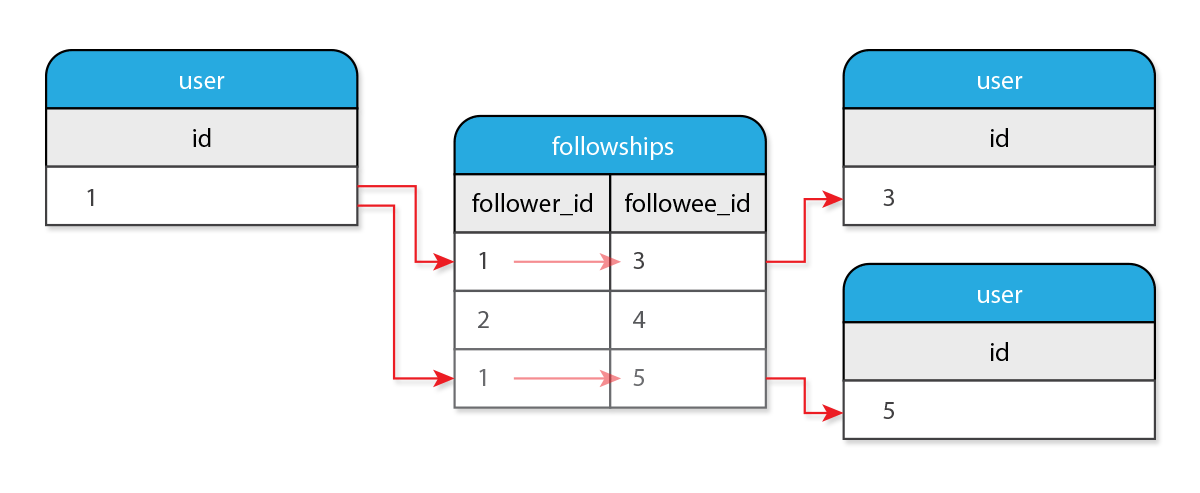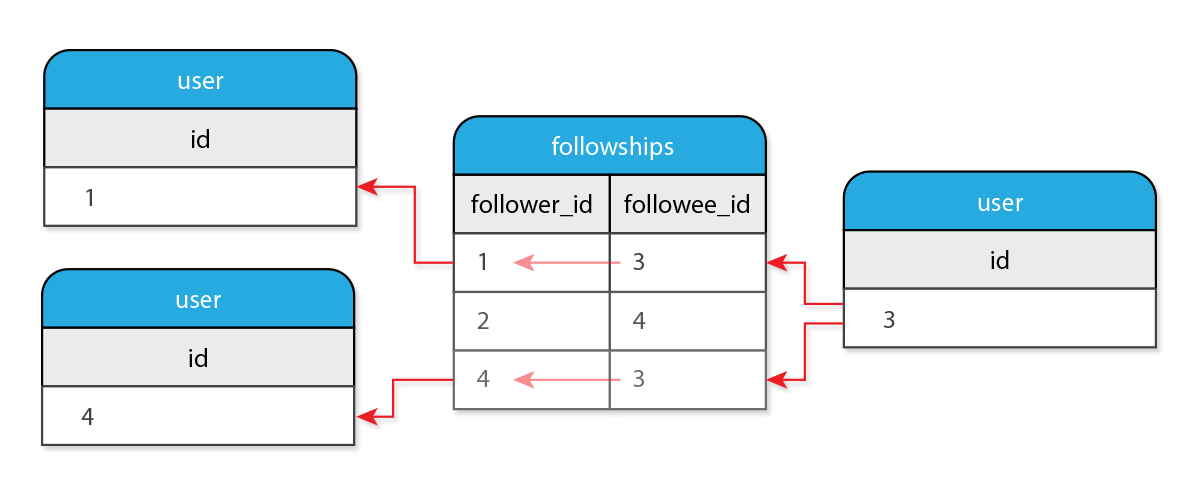Understanding how to implement a feature that enables users to follow each other
Many sites enable users to follow and be followed by other users. It’s a common feature. Dev.to implements it. Twitter implements it.
Michael Hartl demonstrates an implementation in Chapter 14 of The Ruby on Rails Tutorial. I didn’t really understand what was going on at first. It wasn’t until I’d gained a better understanding of ActiveRecord that I fully comprehended what was going on.
Here, I will explain my understanding of how it works.
Most of my following example is identical to Michael Hartl’s implementation.
What am I trying to implement?
Any user can follow any other user. At the same time, any user can be followed by any other user. The relationship is not reciprocal. That is, if one user follows another user, it is not necessary that the other follows back.
Essentially though, whether or not a user follows or is followed, I am describing two sides of the same relationship – one user points to the other.
- I will call a user that follows another user a follower.
- I will call a user that is followed by another user a followee.
- A user can have many followers. Likewise, a user can follow many followees.
- I will describe the relationship between a follower and followee as a followship.
Followships
I now have three concepts: followers, followees and followships.
Followships sounds like the name of a table to me. This table will have two columns. One will point to a follower. The other will point to a followee. Each is referenced by its id.

Knowing this, I can generate a model named Followship. I will add an id column for followers and followees.
(Followships is a special kind of table called a join table. A join table is used to establish many to many relationships – where models can have many of each other.)
I’ll add an index for both follower_id and followee_id since I will want to look up followships by both followers and followees. Also, I’ll place a unique constraint on the rows because it doesn’t make sense that a user follows another more than once.
class CreateFollowships < ActiveRecord::Migration[5.2]
def change
create_table :followships do |t|
t.integer :follower_id
t.integer :followee_id
t.timestamps
end
add_index :followships, :follower_id
add_index :followships, :followee_id
add_index :followships, [:follower_id, :followee_id], unique: true
end
end
Before establishing the relationship in the model, there’s a couple of things to be aware of.
Firstly, an association name does not have to share the name of the model it points to. Let’s say I have the classes User and Project. A user can have many projects:
class User < ApplicationRecord
has_many :projects
end
Each Project belongs to a single User. I could establish the relationship like this:
class Project < ApplicationRecord
belongs_to :user
end
But I would like to refer to the user as the owner of the project.
So how about this?
class Project < ApplicationRecord
# This will not work!
belongs_to :owner
end
Using the above, Rails believes that I want to reference a model name Owner. It infers the class name of the associated object from the name I’ve provided.
So I need to be more explicit.
class Project < ApplicationRecord
belongs_to :owner, class_name: 'User'
end
Now that I know this technique, I can create belongs_to associations for a followship’s follower and followee. Despite their names, both columns point to User.
class Followship < ApplicationRecord
belongs_to :follower, class_name: 'User'
belongs_to :followee, class_name: 'User'
Note: because both of these are belongs_to associations, it is the responsibility of Followship to record the foreign ids of the rows to which it belongs.
From the Rails guides:
4.1 belongs_to Association Reference
The belongs_to association creates a one-to-one match with another model. In database terms, this association says that this class contains the foreign key. If the other class contains the foreign key, then you should use has_one instead.
One final step here. I want to ensure that both the follower_id and followee_id is present. There cannot be a relationship if one is without the other.
The class ends up looking like this:
class Followship < ApplicationRecord
belongs_to :follower, class_name: 'User'
belongs_to :followee, class_name: 'User'
validates :follower_id, presence: true
validates :followee_id, presence: true
end
Catching breath
So what have I done so far?
- I have created a model named
Followship. - Each row in
followshipspoints to afollower_idand afollowee_id. - I’ve indexed by both columns and ensured each pairing is unique.
- I’ve made sure both ids are present in every row.
- I’ve established that
Followshipbelongs to afollowerandfollowee. (In doing so, I’ve had to tell Rails that in both cases I’m actually pointing toUser.)
Connecting User to the Followship
From the point of view of User, followships come in two flavours.
Depending on which way you look at it, a followship can either be a relationship in which the user is a follower of another or it can be a relationship in which the user is a followee of the other.
In the first case, I want to establish that the user has many relationships in which it follows another user. I want to tell Rails that it should reference the user by follower_id in the followships table.
I want the User model to declare to Rails:
“I can have many followships where I am following another user.
“I will refer to these followships as follower_followships.
“In this case, I will refer to myself as a follower.
“Store my id in followship’s’ follower_id field.”
# app/models/user.rb
# ...
# A follower is a user than follows another user.
has_many :follower_followships,
class_name: "Followship",
foreign_key: "follower_id",
dependent: :destroy
(Like the project/owner example above, I have given the association a name that is different from the class it points to. I also know that because the other class is on the belonging side of the relationship, it is the other class that stores the id. In this case, the user id is stored as the foreign key follower_id.
Notice that I have also made the relationship dependent on the user existing. If the user is destroyed, so too are any rows in followships that correspond to it.)
All good but I haven’t yet pointed to another user. So far, User points only to the join table.
Through
Join tables are called such because they join one table to another. They are the glue in a has_many/has_many relationship. (They provide the belongs_to association that stores the foreign keys). Relationships are made through the join table.
I know that each row has a follower and followee column. I know that if my user follows another, its id will be stored in the follower_id column. I also know that in each row my user is recorded as a follower, there will be the corresponding followee_id.
Now I want the User model to declare:
“I can have many followees.
“I can follow many users. Look up my follower_followships. If you see any, the corresponding followee_id in those rows is the id of the followee I am following.”
Like so:

I declare the has_many association with followees through the previously established follower_followships association:
# app/models/user.rb
# To see the users that the user follows, we reference them through the join
# table.
has_many :followees, through: :follower_followships
So far, the User looks like this:
class User < ApplicationRecord
# A follower is a user than follows another user.
has_many :follower_followships,
class_name: "Followship",
foreign_key: "follower_id",
dependent: :destroy
# We reference the users that the user follows through the join
# table.
has_many :followees, through: :follower_followships
Now, I need to do the reverse. I need to establish the other flavour of followship where the user is the followee. A user can be a follower but when other users point to it, it is also a followee.
# A followee is a user that is followed by another user.
has_many :followee_followships,
class_name: "Followship",
foreign_key: "followee_id",
dependent: :destroy
And I can look up followers through the join table:
# To see the users that follow a user, we reference them through the join
# table.
has_many :followers, through: :followee_followships
And now, followees can look up followers through the join table.

A couple of convenience methods
I can now access the users which a user follows by calling self.followees.
Knowing that, I can create two methods that allow me to follow and unfollow users conveniently.
def follow(user)
followees << user
end
def unfollow(followed_user)
followees.delete followed_user
end
The final class looks like this:
class User < ApplicationRecord
# A follower is a user than follows another user.
has_many :follower_followships,
class_name: "Followship",
foreign_key: "follower_id",
dependent: :destroy
# To see the users that the user follows, we reference them through the join
# table.
has_many :followees, through: :follower_followships
# A followee is a user that is followed by another user.
has_many :followee_followships,
class_name: "Followship",
foreign_key: "followee_id",
dependent: :destroy
# To see the users that follow a user, we reference them through the join
# table.
has_many :followers, through: :followee_followships
def follow(user)
followees << user
end
def unfollow(followed_user)
followees.delete followed_user
end
end
In the wild
Dev.to’s implementation is more complicated as it deals with polymorphic associations. However, something similar can be seen in mentor_relationship.rb and in the relevant part of User.rb:
has_many :mentor_relationships_as_mentee,
class_name: "MentorRelationship", foreign_key: "mentee_id", inverse_of: :mentee
has_many :mentor_relationships_as_mentor,
class_name: "MentorRelationship", foreign_key: "mentor_id", inverse_of: :mentor
has_many :mentors,
through: :mentor_relationships_as_mentee,
source: :mentor
has_many :mentees,
through: :mentor_relationships_as_mentor,
source: :mentee
Wrapping up
What have I done?
- I’ve created a model called
Followship. - I’ve established the
Followshipmodel belongs to afollowerandfollowee. - The corresponding table
followshipsis a join table. Users will relate to each other asfollowersandfolloweesthrough this table. - Each row in the
followshipstable stores afollower_idand afollowee_id. - I’ve established the a
Usercan have manyfollower_followshipsand manyfollowee_followships. - A
follower_followship(afollowshipin which the user does the following) is where the useridis stored underfollowship’sfollower_idcolumn. - A
followee_followhsip(afollowshipin which the user does is followed) is where the user’sidis stored as a foreign key underfollowship’sfollowee_idcolumn. - A user can have many
followeesthroughfollower_followships. - A user can have many
followersthroughfollowee_followships. - I’ve added a couple of convenience methods to follow and unfollow users.
What did I need to understand to get here?
- A model that belongs to another model is responsible for storing the other model’s id as a foreign key.
- I can establish many to many relationships through a join table.
- I can give a relation a name that is different from the name of the class it refers to.